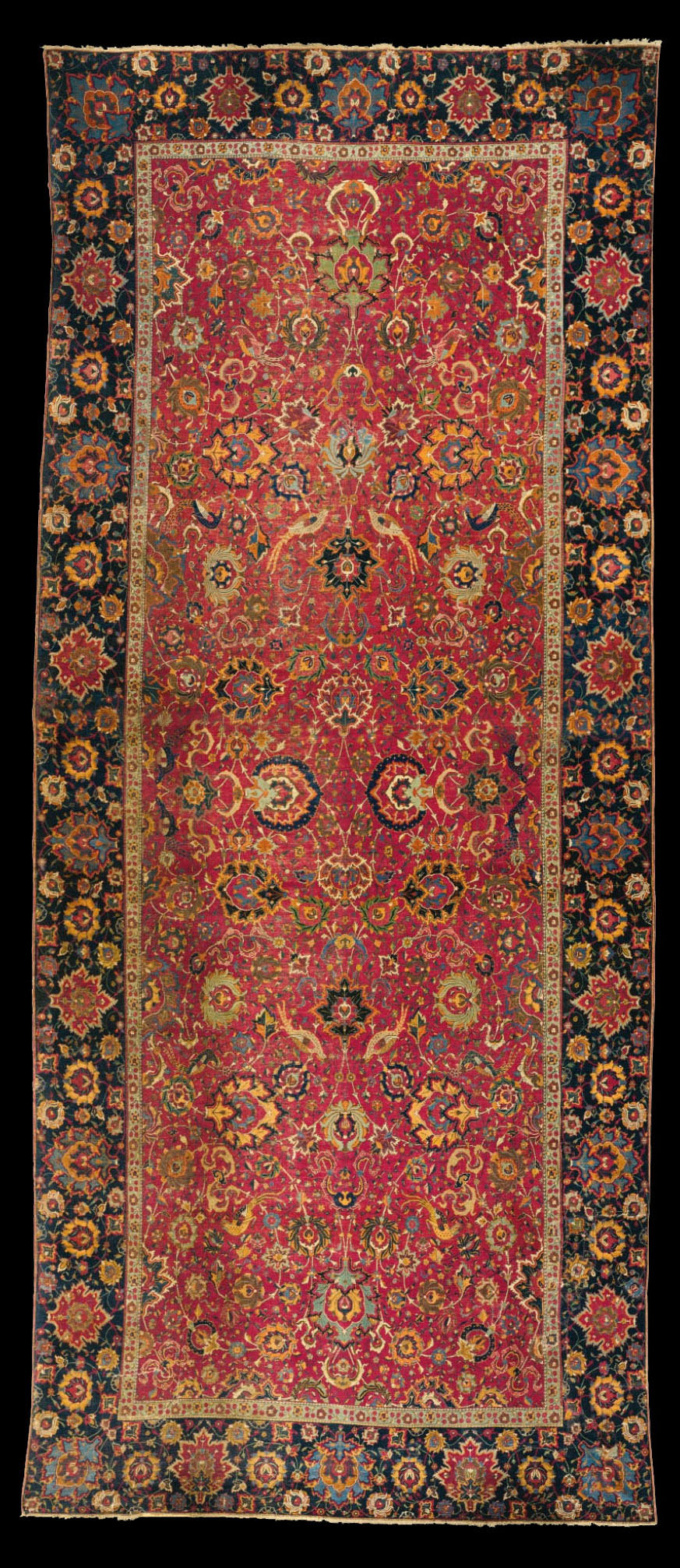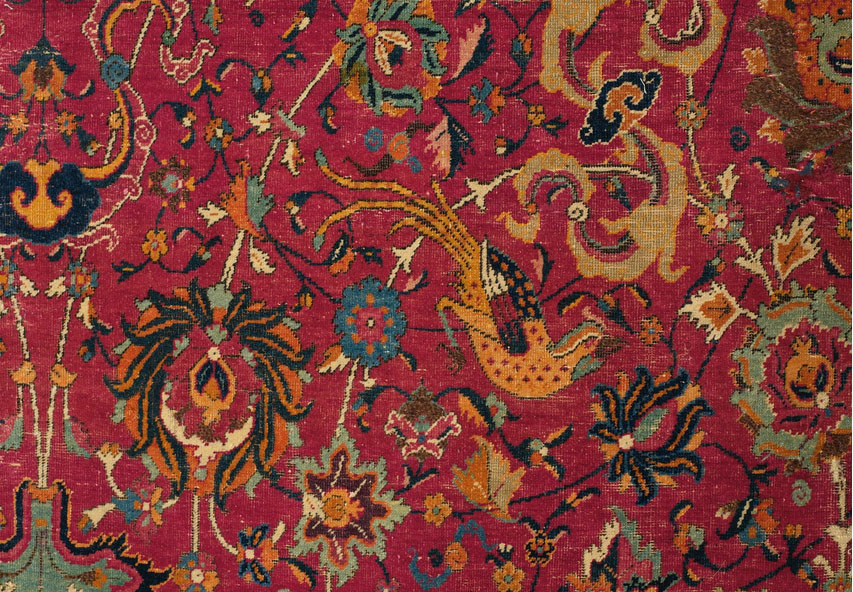|
Masterworks
New York | 01 Feb 2013, 11:30 AM | N08964
Sotheby's
LOT 22
PROPERTY FROM THE COLLECTION OF GORDON P. GETTY
A SAFAVID CARPET, ISPHAHAN, CENTRAL IRAN
approximately 16ft. 5in. by 7ft. 2in. (5.00 by 2.18m.)
late 16th century
ESTIMATE 500,000-700,000 USD
Lot Sold: 1,930,500 USD
PROVENANCE
Collection of Edmond de Rothschild (1845-1934), Paris
With Colnaghi Oriental, London, circa 1975
With The Textile Gallery and Elio Cittone, Milan
Property of a Canadian Collector, sold Christie's London, 17 October 1996,
lot 404
Property of a Private Collector, sold Sotheby's New York, 20 September 2001,
lot 221
LITERATURE
Hali, Volume II, No. 2, p. 65, Colnaghi advertisement, detailHali, Issue 90,
p. 118 and 124
Hali, Issue 120, p. 125
CATALOGUE NOTE
Technical Analysis
Warp: silk, Z2S, yellow
Weft: cotton, Z2S ivory, 3 shoots
Pile: wool, asymmetrical knot, open to the left
Density: 15-17 horizontal; 15-17 vertical
Sides: not original
Ends: not original
This richly colored carpet with its complex, layered design of spiraling
tendrils terminating in palmettes belongs to the
red ground, so-called "spiral-vine" or “in and out palmette,” group of
carpets believed to have been woven in Isphahan
during the Safavid dynasty (1502-1732.) This particular design appeared
first in the sixteenth century and continued
to find favor throughout the seventeenth century. In the present lot, the
flowering, swirling vines are supported by
sinuous cloudbands and pairs of birds of varying plumage. The earliest
examples of the spiral-vine carpets are
characterized by the use of silk in the foundation, an unusually wide
variety of colors and superbly delineated drawing,
as in the present lot. The most well- known carpets that belong to this
early group are the pair of “Emperors’ Carpets”
with one now in the Metropolitan Museum of Art in New York and the other in
the Museum of Applied Arts in Vienna;
see respectively Dimand, M., and Mailey, Jean, Oriental Rugs in the
Metropolitan Museum of Art, New York, 1973, fig.
76, cat.no. 12; "The Emperor's Old Carpets," Hali, issue 31, p. 15. These
two carpets feature animals in the design in
addition to the birds and cloudbands found here.
In Safavid Persia, silk was one of the most expensive materials available,
and therefore was reserved for use by the
court, and the most elite workshops where highly skilled weavers executed
designs supplied by court artists. The
crisply drawn, intricate and symmetrically balanced design of the present
carpet suggests that it was almost certainly
executed from such a very detailed cartoon. This, coupled with the use of
silk in the foundation, indicates that the
present lot can be justly labeled as a “court carpet” – a term often
erroneously applied. Silk was so highly prized and
prestigious a commodity that some contemporaneous carpets woven on cotton
warps would then have silk fringes tied
to the warps, a feature seen even on the iconic “Emperors’ Carpet” in Vienna,
see Hali, op.cit., p. 15. Exporting silk at
high profits to neighboring countries, or even as far as Italy, provided
substantial income for the Safavid court.
Just how extremely treasured silk was is illustrated by the fact that Sultan
Selim I attempted to ban the export of silk
from Persia to the Ottoman Empire in order to weaken the Safavid economy.
Interestingly, by the end of the seventeenth century the “in and out
palmette” pattern fell almost completely out of
favor in Persia as well as in the export markets of England and of
continental Europe. Surviving documentation from
the East India Company, which was the main exporter of these carpets to the
West, indicates the decline of popularity
of “in and out palmette” carpets. A letter from the company’s governors from
1686 state: “You must never send us any
more Persian carpets, for those that we had by way of Surat will not yield
us here above a third of what they cost in
Persia, which gives us just that cause to fear that we were abused in the
price of them, the greater cause of our loss
being that such rich carpets are now grown much out of use in Europe,” see
J. Irwin, “Indian Textile Trade in the
Seventeenth Century,” Journal of Indian Textile Trade, I, 1955, pp. 5-33. In
the nineteenth century there was a
resurgance of Western interest in the exotic which included carpets from the
East or the Orient. The red ground,
spiral vine and palmette carpets such as this lot were once again in great
demand with carpets such as this being as
prestigious and coveted as Old Master paintings by collectors such as the
Rothschilds, J.P Morgan and the Fricks, inthe first quarter of the twentieth
century. The vivid color and remarkable state of preservation of the carpet
offered
here attests to its having been a treasured object for over 400 years.
Another related carpet with only birds embellishing the spiral-vine pattern
is the “Enzenberg spiral-vine carpet” in the
Thyssen-Bornemisza Collection, see Spuhler, F., The Thyssen-Bornemisza
Collection: Carpets and Textiles, London,
1998, pl. 20. More closely related to the field design of the carpet offered
here is that of a carpet from the Kelekian
Collection, see Arthur Upham Pope, A Survey of Persian Art, London and New
York, 1939, pl. 1186. According to
Pope, carpets such as this lot may have been woven for use in mosques as
they omit depicting any animals or human
figures which would be considered sacrilege, while the representation of
birds was permissible, see ibid., p. 2363.
Another closely related silk foundation carpet, although somewhat less
complex in design as it does not depict birds,
sold Christie’s London, 16 April 2007, lot 100 ($1,530,014). Related
fragments include one from the Collection of the
late Robert De Calatchi, Paris and sold Sotheby’s London, October 4, 2000,
lot 79; one in the collection of the Victoria
and Albert Museum, London, see Kurt Erdmann, Der Orientalische Knupfteppich,
Tubingen, 1955, Abb. 79; one from
the collection of Mrs. Nelson A. Rockefeller sold Sotheby’s New York, June
4, 1998, lot 10; and another at Galerie
Koller, Zurich, March 28, 2001, lot 1061.
Fig. 1
The house of Edmond de Rothschild, 41 Rue du Faubourg SaintHonore Paris.

 |


